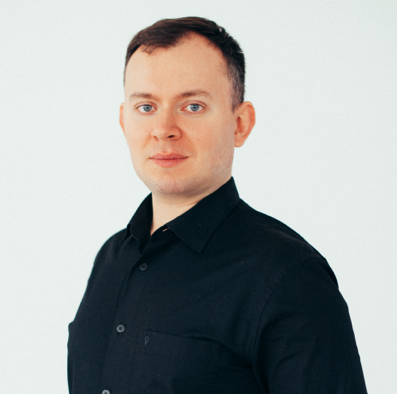Project development success depends on many things such as strategy, planning, and investment. Of course, these are important, but all projects start with people. That’s why you need a carefully selected team of software developers and well-functioning development processes. The dream of every business is to create a mechanism that works like a Swiss watch and requires minimal intervention, and a cohesive team is a reliable foundation for successful project development. In this article, we’ll tell you how to structure a software development team as well as describe the typical team composition for a software development project.
Table of contents:
- The main roles within a software development team
- How to structure a software development team
2.1 Choose the kind of team type your project needs
2.2 Define software development team size
2.3 Select the right specialists
2.4 Set clear goals and objectives - Final thoughts
The main roles within a software development team
The structure of a development team depends on many factors since the team members are selected for each individual project. However, there are some roles that form the basis of such a team. Before getting into the question of how to structure a software development team, it is necessary to know the main roles in a software development team and their areas of responsibility.
Project Manager (PM)
A PM is responsible for the initiation, management, and delivery of a project. This specialist acts as a bridge between the development team and the product owner team. Project work starts with the Project Manager, it is managed (tasking), controlled (quality and efficiency control), and delivered to him/her. In most companies, PMs also manage the project fund.
Business Analyst
Business analysts communicate with customers and find out their needs and requirements. The task of the business analyst is to understand what the customer wants, how he or she sees the product that a development team needs to build, the product’s purpose, and what tasks it will solve. When communicating with the customer, a business analyst can offer them ideas on how to improve the product and form the project vision together with the customer.
Developers
Software developers are engaged in the production of software products. Basically, these are specialists who write the code and carry out the technical implementation of the project idea. The number of developers on a team depends on the complexity of the project and the scope of work. This is the executor’s role: a project manager sets a task to automate a process, and developers fulfill it. Developers are segmented by division of responsibility:
- Backend developer – developer of the software and hardware part.
- Frontend developer – developer of the client-side of the user interface.
Developers are also segmented by platform, e.g., web developers, mobile developers, server-side developers, and so on. Different types of projects require different developers, so there is no single rule to determine which programmers belong on any given team.
Team Lead
He or she is responsible for the work of the group of specialists. The team lead provides a comfortable working environment for the team and maintains a high level of its efficiency. This person doesn’t necessarily have to be a programmer, he or she just has to know how to organize the work as well as to understand the processes of the software creation.
The role of the team lead should not be confused with the role of the tech lead. The tech lead is a technician responsible for improving technical solutions. This role involves deep immersion in project architecture and technology to optimize operations and reduce technology risks.
UX/UI Designer
This specialist is responsible for the production of the graphical components of user interfaces. A designer develops the visual portions of the interface while taking into account the logical user interaction with the product. The skills of the UX/UI designer determine not only the look and feel of the software product but also how easy it will be to navigate as an app or platform. The main goals of designers are to establish the intuitiveness, simplicity, usability, and aesthetics of the software interface.
Quality Assurance (QA)
No software product can be created without testing and quality control. This is where QA specialists come into play. QA deals with the testing of everything, no matter how strange it may sound. This includes testing the developed functionality, security, compatibility, system vulnerabilities, and much more. The system approach of a QA specialist examines both the program code and the thoughtfulness of the user experience maps.
How to structure a software development team
Now let’s talk about the basics that will help you to find out how to structure a software development team. These factors directly affect the team composition as well as its size.

Choose the kind of team type your project needs
What is the best way to organize a software development team? First of all, it is necessary to choose the kind of team your project needs. There are three main types of development teams you can choose from:
- Team of generalists – developers that possess a broad range of knowledge and expertise and can handle end-to-end solutions.
- Team of specialists – developers who are highly skilled in a particular field that use all their knowledge and expertise, which results in more efficient and effective work.
- Hybrid team – a team of junior, middle, and senior developers that combines the best from the generalists and specialists.
Software development team composition depends on the product that needs to be developed. Also, the size of the team depends on the complexity of the development and the deadlines. The more complex and faster the project needs to be delivered, the larger the team needs to be, and vice versa.
You should pay special attention to the level of seniority and expertise of the team. For example, if you are looking for a blockchain solution, make sure the selected developers have experience in this area and a sufficient number of specialists that are ready to implement your project on time.
Read our article: “How to choose blockchain developers?”
Define software development team size
How should you build a software development team and what is the optimal size of the team? These simple questions point to one of the primary concerns that arise when building a development team, but there is no definitive answer.
The size of the software development team depends on:
- Complexity of the project
- Budget
- Deadline
- Available resources
- Full or part-time employment
As Scrum methodology shows, the optimal team size is between 3 and 9 members with 7 being the most perfect fit for software development. But if you need a bigger team, it’s okay. The key here is to carefully manage your crew following your project requirements.
As the size of the team increases, the number of interactions between team members increases proportionately. As the simple mathematical relationship proves: the number of possible personal interactions between “n” members equals n*( n – 1)/2. For example, on a nine-member team, the number of possible interactions for each member is 36, while on a four-member team the number of possible interactions is only 6. So, make sure your development team is in good hands and the process is set up correctly.
Select the right specialists
The effectiveness of the team depends largely on the personal qualities of its members and the relationships between them. Each team member should be prepared to apply his or her abilities and knowledge to the tasks of the team.
That is why the requirements of the work to be done should be carefully analyzed beforehand. This determines the level of competence, which includes the knowledge, skills, and personal qualities that team members should possess. Understanding the full list of tasks will allow you to assemble the perfect combination of specialists of the required level of seniority and skills.
Set clear goals and objectives
All team members must be aware of the connections between goals, working methods, and objectives. Goals should be clear, and focused, and create a vision of the work plan that will lead to success.
In order to clearly set and solve project tasks, it is necessary to consider a variety of expectations. A software development team’s goals should be the foundation of its operations, but significant external factors may cause them to be revised. This is why we advise you to use agile development methodologies and draw up detailed work plans, including software development specifications and more.

Final thoughts
A good development team includes everyone we’ve listed in this article: a project manager (PM), a business analyst, backend and frontend developers, a team lead, designers, and quality assurance (QA) specialists. To choose the best team members, you should define team type (generalists, specialists or hybrid) and then its size which depends on the complexity, budget, deadlines, available resources as well as full or part-time employment of the members.
You should also clearly set goals and objectives to give team members an understanding of what they will do. Knowing the technological stack, you can discuss the team composition with a software development provider.
Here are a couple of final tips:
- Discuss the number of specialists needed (remember that 10x developers won’t make the development process 10 times faster).
- Decide on the qualification of the team members (you obviously don’t need only senior developers and in most cases it is a waste of money).
- Do not forget to put at least one senior developer on the team to lead them (it is mandatory to check the team lead’s hard & soft skills).
- Work with a project manager. They are the main coordinators that help resolve all work-related issues.
Summarizing all of the above, it is worth noting that the software development team consists not only of developers but also of other specialists responsible for the different stages of software product creation. We hope this article was useful for you and now you have a clear idea of how to structure a software development team and all of the particulars of this process.

